NRL Hunter Matches sharpen real-world hunting skills by challenging shooters to locate, range, and engage targets under pressure. It’s the ultimate field-shooting practice. Editor George Krumm took on the challenge and this is what he learned.
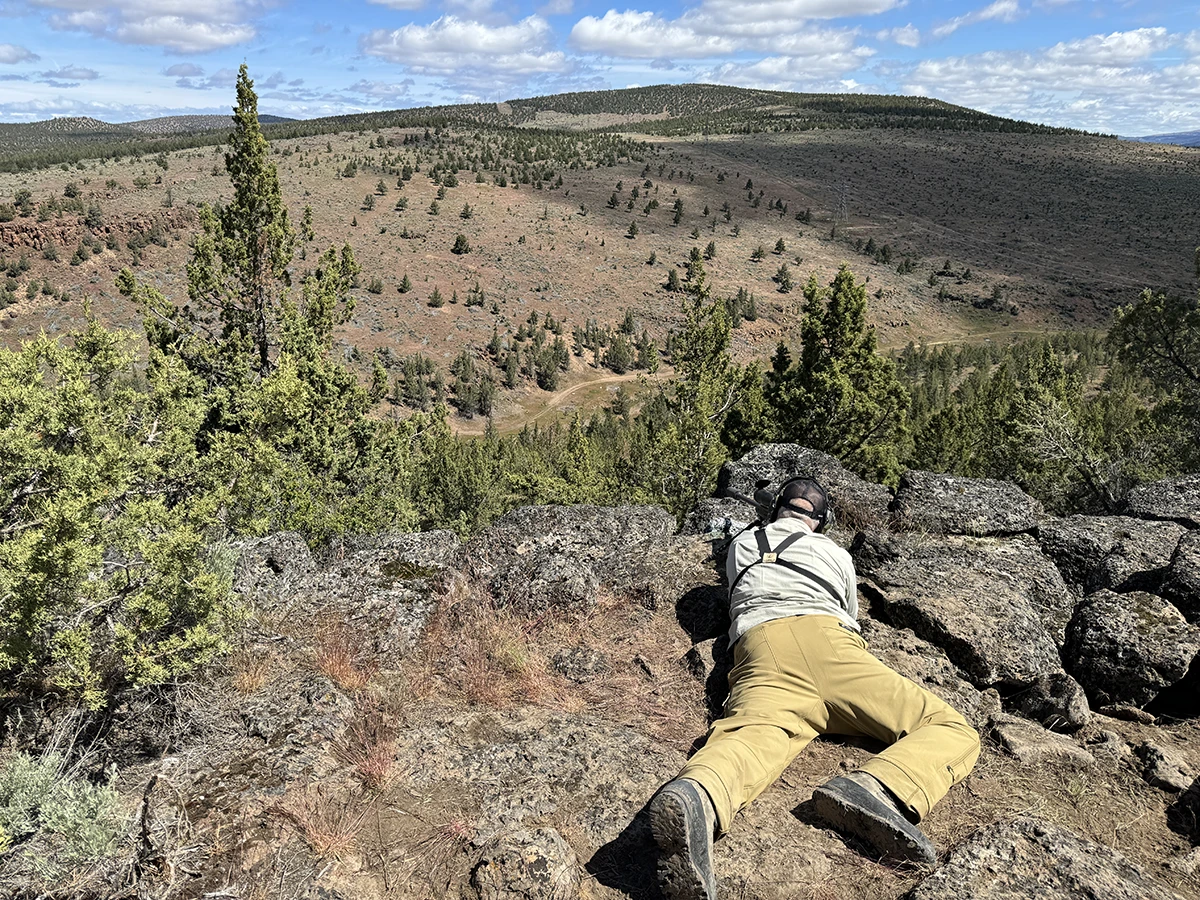
Author George Krumm flopped down prone on the basalt rocks to engage targets in the trees just beyond the dirt road. Since stages are timed, you might get a little beat up at an NRL hunter match.
Leupold Relentless Rifleman NRL Hunter Match
“IMPACT!! Next target.”
Those words pushed a surge of adrenaline through my veins. I was on the clock, and time was running low. As I swung over to the second target I heard the “Pock” of my bullet finally reaching me from the steel target I just shot 750 yards away. The second target—a wolf silhouette, was visible between and beyond two cottonwood trees. I had ranged it at 850 yards with my Leupold BX-4 Range HD binos. I dialed 16 MOA on my Leupold Mark 5HD 5-25, picked up the target in the scope, checked level, tried to control my breathing, began to squeeze…The recoil bounced the rifle a little but I didn’t lose my sight picture.
I saw the shock wave of the bullet hitting the target and heard that most gratifying exclamation again: “IMPACT!” I hustled over to the second shooting position and settled in prone to engage the first target again. I squeezed of the round, saw my bullet fly high and heard, “RE-ENGAGE!” from the Range Officer (RO). Immediately, I realized I forgot to dial my scope back down for the 750-yard target. Pissed off at myself for such a bonehead move, I quickly made the correction and let a second round fly. “IMPACT!” I swung over to the 850-yard target and dialed my scope. “TIME!”
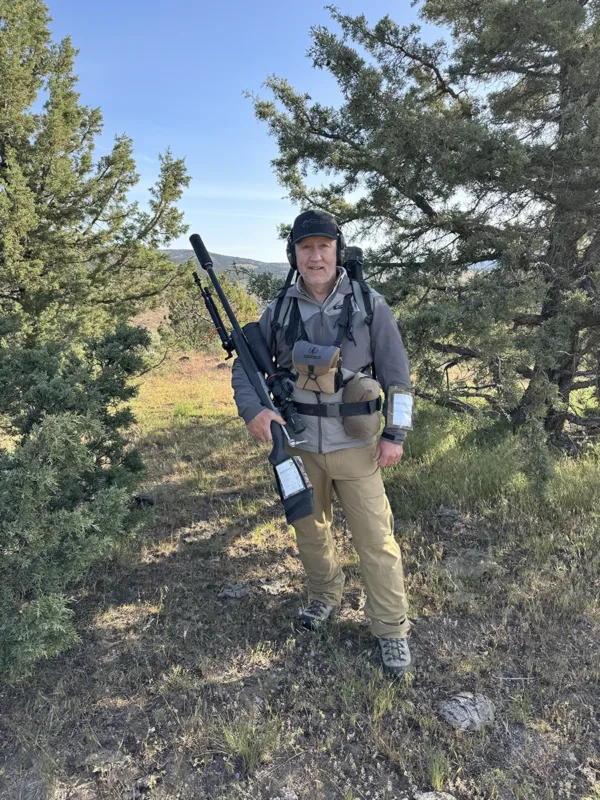
The author, George Krumm, ready as he’ll ever be. NRL Hunter matches will greatly improve your ability to shoot game in the field.
Don’t miss the first-ever Alaska NRL Hunter match
2025 Alaskan Wilderness Hunter
June 20–22, 2025 | Cantwell, AK
The Thrill of Competition
That was all for that stage, but I was so excited I was shaking! I’m feeling the excitement even now as I relive the experience by writing. The Leupold Relentless Rifleman NRL Hunter Match was the first match I’d ever shot in. It was incredibly exciting, challenging, exhilarating, humbling, and supremely educational regarding my rifle’s capabilities and my capabilities shooting at a variety of ranges and angles, and building whatever shooting position I could to engage those targets while under the pressure of a ticking clock. I learned more about myself and my abilities and probably improved more as a result of those two days than I have in the past decade. I can’t wait to do it again. I think every hunter ought to shoot in a match or two every year if they can afford to do so and have the time.
Overcoming Fear and Taking Aim
It all started in the winter of 2023/24. While chatting with Sarah Stallone, Hunt Alaska’s “Practical Precision” columnist, owner and shooting instructor at Accurate Advantage in Anchorage, and Territory Manager for Leupold Optics, she suggested I should consider shooting in the Leupold Relentless Rifleman NRL (National Rifle League) Hunter match in Madras, Oregon. Having never shot in a match of any kind, I was reluctant. More accurately, I was afraid I would do poorly. But I was also intrigued. Sarah said she and some friends from Alaska were flying down to participate. She said she might be able to get me assigned to their squad. She was making it harder and harder to say no. Being very interested in learning to shoot well at longer hunting ranges, I decided to walk through my fears and sign up.
I showed up Friday afternoon, May 24th. I walked up to the registration tent where they were weighing rifles. I signed up in the Skills division, which I think might have been jokingly called the No Skills division initially. It’s for beginners to NRL Hunter, and it offers newbs some help. If you’re registered in Skills, you can walk up to a stage before your turn and watch others shoot it. That will tell you were the targets are, and you’ll see how they handle the terrain and build shooting positions to engage those targets. Also, when shooting in Skills, you can ask the RO for help.
NRL hunter gear list (suggested minimum)
- Rifle, within weight limits (either less than 12 pounds or less than 16 pounds depending on division, and includes optics, rings, bipod, and muzzle device) and with a minimum power factor 380,000; max velocity 3,200 fps
- Rifle scope that you can dial for elevation
- Sturdy tripod
- Tac table
- Bipod
- Rangefinder and binoculars, or range-finding binoculars
- Backpack
- Appropriate clothing for the conditions. Hunting clothing generally works; kneepads are helpful
- At least 160 rounds of ammo
- Two 4-round magazines if you use detachable mags
- Ear protection
- Shooting glasses
- Shooting bag or bags
- Quarterback sleeve for dope cards
Finding Targets
Since individuals get four minutes on the stage to find and engage all the targets, you can have the RO help you find them if you’re having difficulty. I don’t know how other NRL Hunter matches are, but many of the targets at Relentless Rifleman were rather difficult to find. The downside to being in Skills is you aren’t actually competing for trophies or awards. You still get scored on your scorecard though.
Dialing In: Zeroing My Rifle and Verifying Power Factor
I got my rifle weighed and they told me where I could go to zero my rifle and to get my power factor verified. I went back to my truck, grabbed my pack and headed to the practice range. Since I’d zeroed my rifle using Hornady’s 4DOF app and zero angle, I didn’t need to re-zero. I just needed to update environmental data which I had actually done the day before based on weather forecast and the range altitude. I also created my dope card at home using those same environmental estimates. I just needed to fire a few shots to verify nothing had gotten bumped in transit and to determine power factor.
The ROs gave me a Garmin Xero C1 chronograph to determine power factor. I shot one shot at a 1” dot at 100 yards, then shot two more at a small steel target at 265 yards. My average velocity was 3,024 fps, and I was shooting a 6.5 PRC with Hornady factory Precision Hunter loads with 143-grain bullets, so my power factor was 432,432—well over the required minimum power factor of 380,000. Then I shot a few shots at 400+ yards and hit the target with all of them. Good to go!
The next morning, I drove to the range and met up with my squad. We were squad 11, and we were to start on stage 11. The plan was to shoot stages 11 through 20 on Saturday, and stages 1 through 10 on Sunday.
First Day with the Squad
The range was located in the high desert of eastern Oregon. The range was situated along a horseshoe-shaped canyon, and the distance from stage 1 to stage 20 was probably 2.5 miles or so. The stages were all up on the rimrock, and the targets were generally down in the creek bottom or up on the other side of the canyon. Targets ranged from about 225 yards out to about 950 yards. Targets were animal silhouettes and ranged from 1.5- to 2 MOA in size. To put that in perspective for those of you not conversive in MOA, 1 MOA is about an inch at 100 yards. 1 MOA is about 5 inches at 500 yards. So, a 2 MOA target at 500 yards is roughly 10 inches in diameter.
Moving Targets
When we approached stage 11, I desperately didn’t want to go first. At the waiting area of each stage there is a little sign with a picture of the target shape, and it tells you how many targets and how many shooting positions there are, and how the targets are arranged (left to right, or near to far). There was only one target at stage 11. It was a moving target, a little over 300 yards away, travelling at maybe 3 or 5 mph. What’s more, it was in the creek bottom and it wasn’t visible all the time. I had zero confidence I’d hit that target.
I watched Sarah and her teammate, Sterling Cook when they shot the stage. I think Sarah hit it three out of four shots shooting over her tripod. And I was right—even though I knew where to look for the target and how to set up, I didn’t hit it once. I began to feel trepidation creeping into my bones. It might be a long day…Fortunately, that was the only moving target in the match.
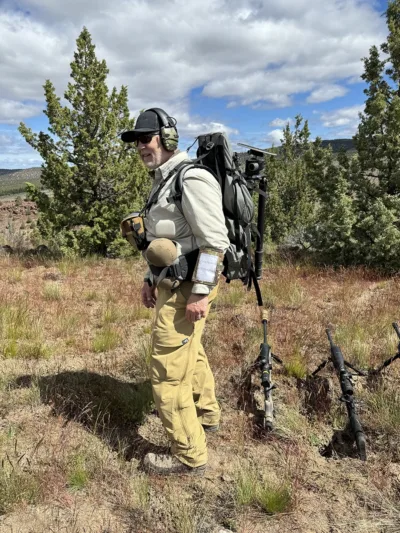
George Krumm in between stages. This is how he carries his gear when he approaches a stage.
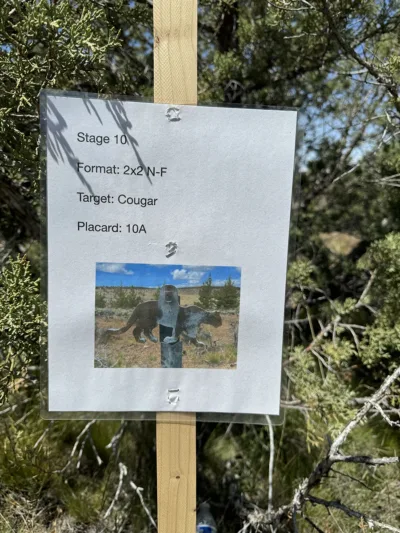
At the waiting area between stages, there is a sign that describes the course of fire. In this case, Stage 10 has 2 shooting positions, and 2 targets arranged near to far. The targets are cougar silhouettes, and the first target will be relatively close to placard 10. Most shooters abbreviate this info on their dope card with a grease pencil or dry-erase marker.

George Krumm shooting prone across the canyon. Shooting in competitions like NRL Hunter will make you a much more lethal hunter.
Utilize the Skills Division Advantages
At a given stage, there was a designated place from which to glass, marked with a green flag. In front of the green flag were two orange flags defining the left and right borders of the stage. The targets were somewhere in front of you in the pie shaped space that stretched from the green flag to 1000 yards distant. The targets were animal shapes, but small, and not painted white or orange. Most of them were multicolored, beat-up rusty pieces of steel that kind of blended in. After using most of my 4 minutes looking for targets on stage 12, I decided I’d take advantage of being in Skills on the subsequent stages.
When the range officer would approach me in the staging area and ask if I understood the course of fire (meaning how many targets there where, what shape, how many shooting positions, and the targets relationship to each other (left-right, or near-far), I’d say yes, and I’d tell the RO that if I reached the two minute point without finding all the targets, to please help me find them so I could at least get some shooting in. That is totally acceptable in the Skills division.
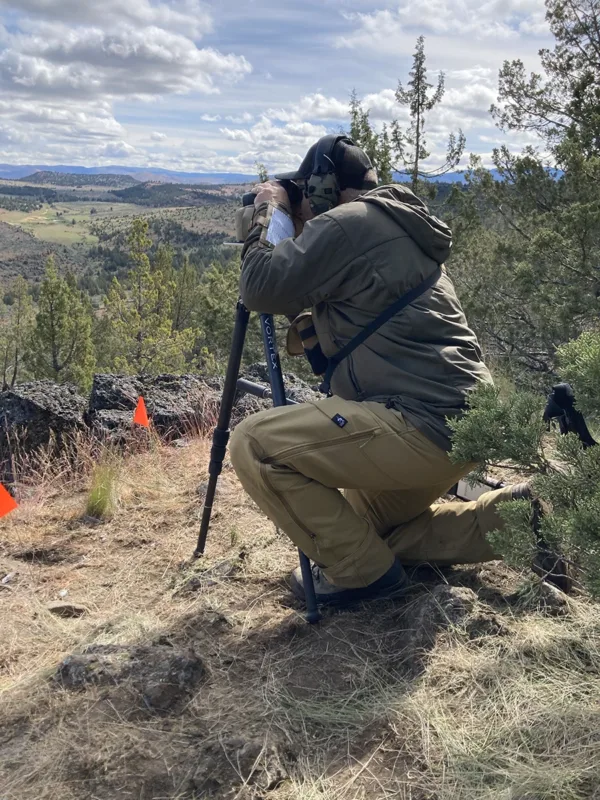
Utilizing a tripod with a shooting bag on top creates a very stable position for glassing and ranging targets. The author likes to range a target 3 times to ensure he gets the right range. Range-finding binoculars, like the Leupold BX-4 Range HDs or the Vortex Fury HD 5000 ABs speed up the process.
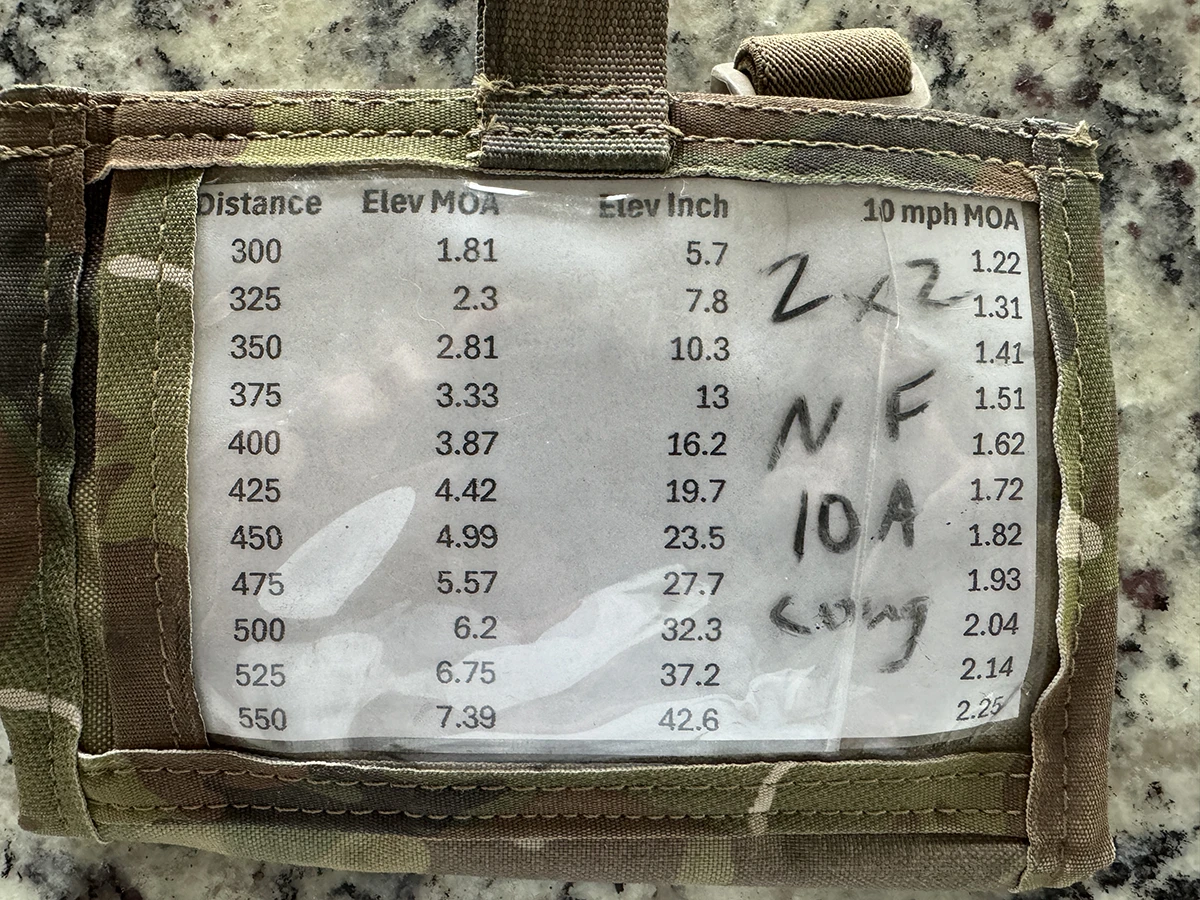
The first of three pages of the author’s DOPE card. Note the grease pencil writing about stage 10.
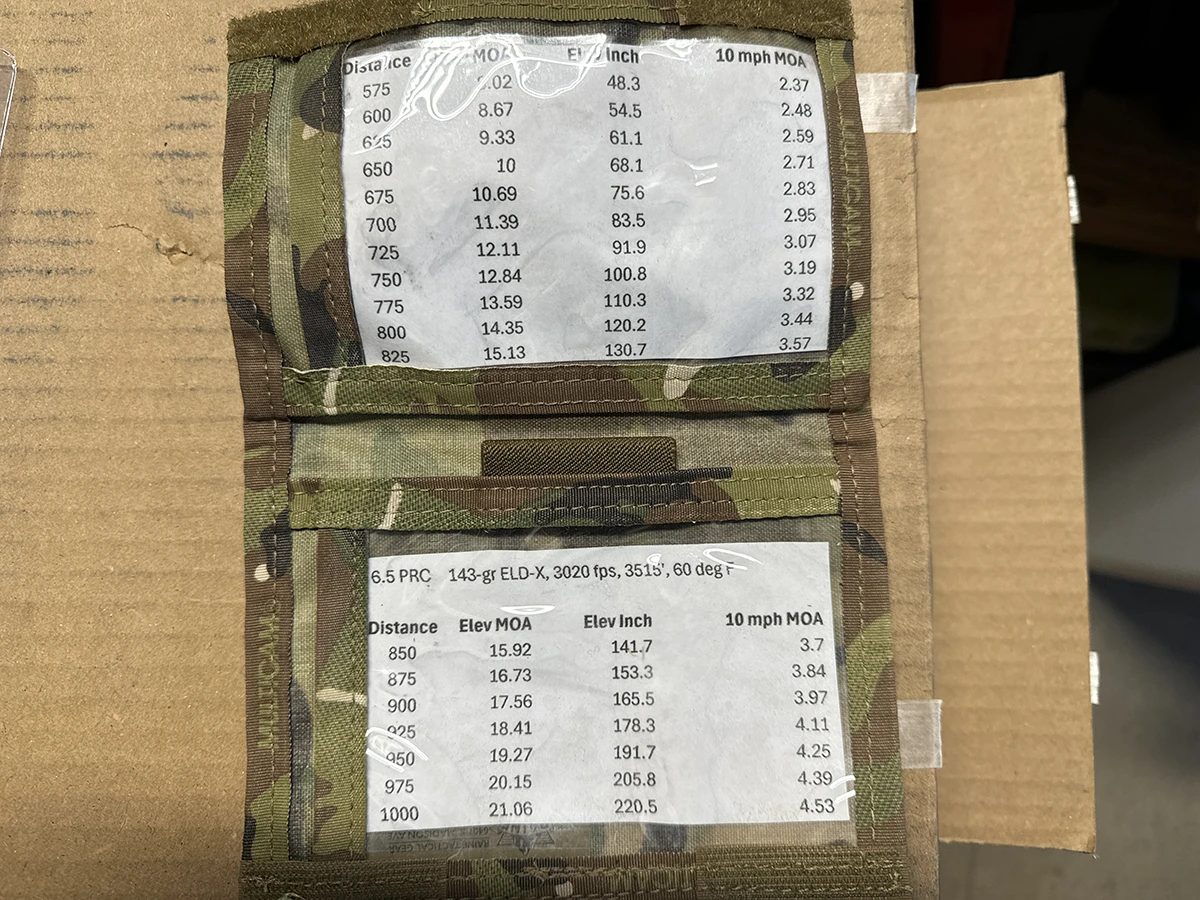
Pages 2 and 3 of the author’s DOPE card. For NRL Hunter, you’ll need DOPE cards going out to 1,000 yards.
Building Confidence on the Range
It quickly became apparent that good shooting fundamentals were important. You need to stay in your scope and manage recoil so you can see your impacts, or where you missed. By the end of the match, I was starting to get good at it. Most of the time, I was able to see my hits or misses. That made it possible to make adjustments when I missed and to re-engage the target.
In NRL hunter, you get a second try at a target if you miss it the first time. Note that with 20 stages, and generally 4 targets/positions per stage, there are a total of 80 targets. If you were to miss your first shot on every target, that means you’d need a total of 160 rounds to shoot the match, plus whatever you need to zero or verify your rifle the day before the match. It’s not cheap to shoot a match, but I found the experience very much worth the expense.
During the course of the match the camaraderie grew among the members of our squad. I was really having a great time, and I’m grateful to Sarah, Sterling Cook, Kevin Garcia, Tom Moyle, and Richard Mullowney for letting me tag along with them. I learned an awful lot talking to and watching each of them as they worked through the stages.
2025 Alaskan Wilderness Hunter
While at dinner on Saturday night, they talked about starting an NRL Hunter match in Alaska. Well, they did it. The first-ever Alaska NRL Hunter match is called 2025 Alaskan Wilderness Hunter, scheduled for June 20-22, 2025. It will take place near Cantwell, Alaska. It will undoubtedly sell out, so register right now if you’re interested. I’ve already registered. It is possible it will be sold out by the time this issue hits the newsstands, but if it isn’t, don’t dally. Go to nrlhunter.org/2025-alaskan-wilderness-hunter/ to learn more and to register.
NRL Hunter Matches Sharpen Your Shooting Skills and Field Readiness
In the era in which I grew up, most hunters didn’t practice shooting very much. That has changed a little, but by and large, hunters aren’t nearly as good at shooting as they could be. Many hunters go to the range a few weeks before hunting season zero in their rifles and maybe fire a few more shots from a bench and call it good. As such, they are woefully ill-prepared to rapidly build a shooting position in field conditions, then execute an accurate shot. If that same hunter shot in an NRL Hunter match or two a year, they would be many times more lethal in the field. NRL Hunter forces you to become familiar with your equipment and weapon, under the pressure of a ticking clock. You get a lot of repetitions in, in varied terrain, and with targets at varied, unknown ranges. It’s tough. You will be tested. It is humbling. But you will improve.
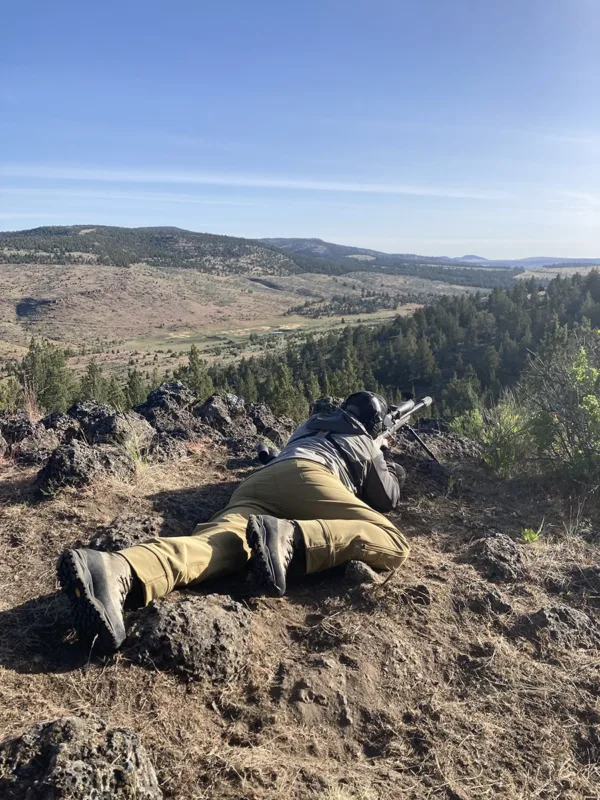
The author shooting at a little gopher target hidden in the trees across the canyon. The people who designed the course of fire must be sadists. Those rocks certainly made things challenging. Kneepads help.
I’ll say it again: I learned more about my shooting ability and improved my shooting ability more in one weekend—one NRL Hunter match—then I’ve probably learned in the past decade of casual range shooting. I highly encourage you to consider participating in an NRL Hunter match this year. I guarantee you will not regret it.
George Krumm is the Editor of both Fish Alaska and Hunt Alaska magazines. He can be reached at george@fishalaskamagazine.com.
Find more reading at Hunt Alaska’s Blog Archive.








